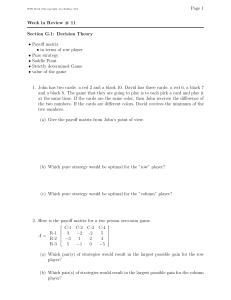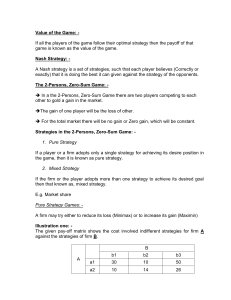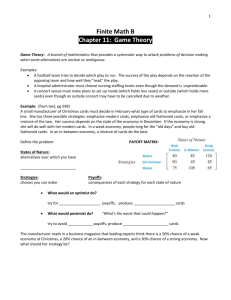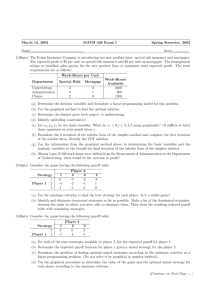Introduction to Game Theory
advertisement
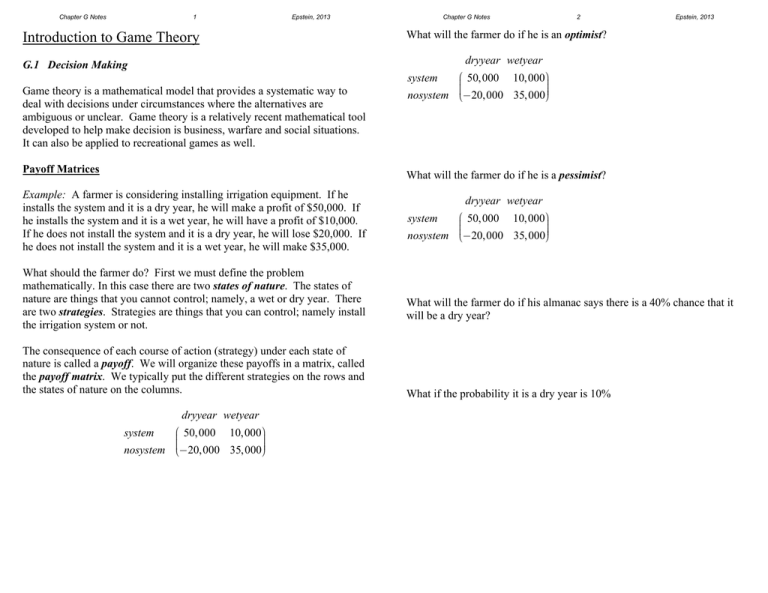
Chapter G Notes 1 Epstein, 2013 Introduction to Game Theory Chapter G Notes 2 Epstein, 2013 What will the farmer do if he is an optimist? dryyear wetyear G.1 Decision Making æ 50,000 10,000ö÷ çç ÷ nosystem çè-20,000 35,000÷ø system Game theory is a mathematical model that provides a systematic way to deal with decisions under circumstances where the alternatives are ambiguous or unclear. Game theory is a relatively recent mathematical tool developed to help make decision is business, warfare and social situations. It can also be applied to recreational games as well. Payoff Matrices What will the farmer do if he is a pessimist? Example: A farmer is considering installing irrigation equipment. If he installs the system and it is a dry year, he will make a profit of $50,000. If he installs the system and it is a wet year, he will have a profit of $10,000. If he does not install the system and it is a dry year, he will lose $20,000. If he does not install the system and it is a wet year, he will make $35,000. What should the farmer do? First we must define the problem mathematically. In this case there are two states of nature. The states of nature are things that you cannot control; namely, a wet or dry year. There are two strategies. Strategies are things that you can control; namely install the irrigation system or not. The consequence of each course of action (strategy) under each state of nature is called a payoff. We will organize these payoffs in a matrix, called the payoff matrix. We typically put the different strategies on the rows and the states of nature on the columns. dryyear wetyear æ 50,000 10,000ö÷ çç ÷ nosystem çè-20,000 35,000÷ø system dryyear wetyear system nosystem æ 50,000 10,000÷ö çç ÷ çè-20,000 35,000÷ø What will the farmer do if his almanac says there is a 40% chance that it will be a dry year? What if the probability it is a dry year is 10% Chapter G Notes 3 Epstein, 2013 Strictly Determined Games Game theory can be applied to a game that two people play against each other. In the previous section we had a player against nature, but now we will have two players. We will need some definitions for a game played with two players. We will call the players A and B and the game is called a two-person game. Player A controls the ROW decisions Player B controls the COLUMN decisions. What the player chooses is called their strategy. The convention is that a positive number in the payoff matrix means that B pays A. A negative number means A pays B. Chapter G Notes 4 Epstein, 2013 Dominated Strategies Consider the following payoff matrix: 1 1 3 2 0 5 2 4 6 First look at the matrix from A's point of view…. If one row is ALWAYS a better option than another row, we removed the row that is worse. This is called removing dominated strategies – we remove a strategy if it would never be chosen anyway. Example: Consider the payoff matrix below. What are the possible outcomes? B 1 1 3 2 0 5 2 4 6 3 1 A 4 7 So we get a new payoff matrix with the dominated strategy removed: Look at the new payoff matrix from B's view. B likes negative numbers, or at least small numbers. This kind of game where if one person loses the other wins that amount is called a zero-sum game. Some games (like a model of the stock market) are not zero-sum games. Chapter G Notes 5 Epstein, 2013 Example: Remove any dominated strategies from the payoff matrix, 8 4 6 1 3 0 9 12 Chapter G Notes 6 Epstein, 2013 Now look at each of A's strategies and see what B would choose as a response to each. A chooses row B chooses column Payoff is 1 2 3 5 6 4 1 2 3 1 3 2 Look at B's choices for columns and what A would do in response to each: The goal of game theory is to find the optimum strategy for each player. The optimum strategy will give the player the most payoff possible. The payoff that results from each player choosing their optimum strategy is called the value of the game. The simplest strategy is for a player to always pick the same row (or same column) every time they play. This is called a pure strategy. Consider the following payoff matrix: 5 6 4 1 2 3 1 3 2 B chooses column A chooses row Payoff is 1 2 3 5 6 4 1 2 3 1 3 2 If a payoff matrix A has an entry ahk that is the minimum in its row (row h) and the maximum in its column (column k), that entry ahk is a saddle point. If a game has a saddle point, then the optimum pure strategy for A is to choose the row with the saddle point and the optimum pure strategy for B is to choose the column with the saddle point. A game with a saddle point is a strictly determined game. A fair game has a value of 0. Chapter G Notes 7 Epstein, 2013 Example : Look at the payoff matrix below. Does it have a saddle point? Is it strictly determined? What is the value of the game? Is it fair? What are A and B’s optimum strategies? Chapter G Notes 8 Epstein, 2013 We can find the expected value of a generalized 2x2 game as shown: 1 4 3 1 1 2 5 0 4 10 1 3 2 5 2 G.2 Mixes Strategies What if a game does not have a saddle point? There is no optimum pure strategy, but a player can have an optimum mixed strategy. 6 2 1 10 Suppose that player A decides to choose row 1 and row 2 with equal probability. Next suppose that player B decides to choose column 1 two thirds of the time and column 2 one-third of the time. Finally, assume that A and B make their choices independently Outcome R1, C1 R1, C2 R2, C1 R2, C2 Probability Expected value for A is Payoff to A If we have a larger game, one with m rows and n columns, then the payoff matrix will be an mxn matrix. A's strategy will be a 1xm matrix B's strategy will be an nx1 matrix. Chapter G Notes 9 Epstein, 2013 OPTIMUM MIXED STRATEGY. 6 2 What is the optimum mixed strategy for the payoff matrix ? 1 10 Assume A chooses row 1 with probabilityp1 and row 2 with probability p2. Determine what A will win under the conditions that B always picks column 1 or B always picks column 2. Chapter G Notes 10 Epstein, 2013 a a If we have a generalized payoff matrix, M 11 12 a21 a22 A's optimum mixed strategy is p1 a22 a21 and p2 1 p1 a11 a22 a12 a21 B's optimum mixed strategy is q1 a22 a12 and q2 1 q1 a11 a22 a12 a21 The number of cases of African flu has reached epidemic levels. The disease is known to have two strains with similar symptoms. Dr. Hyde has two medicines available. The first is 60% effective against the first strain and 40% effective against the second strain. The second medicine is completely effective against the second strain and completely ineffective against the first strain. a) Write a payoff matrix to show Dr. Hyde's results. b) What is Dr. Hyde's optimum strategy? c) What results can she expect?
